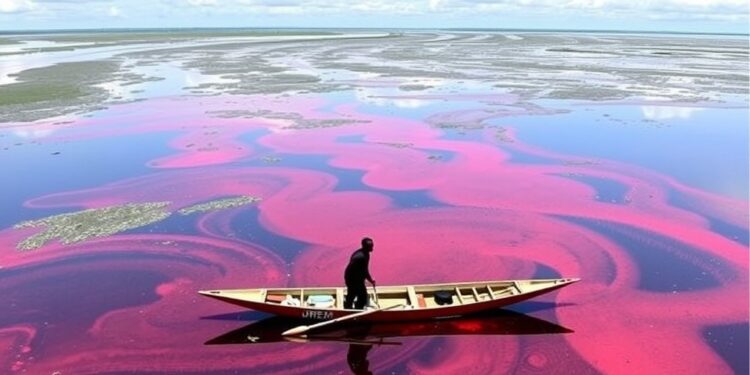
In a groundbreaking investigation, researchers have turned their attention to the Winam Gulf of Lake Victoria in Kenya, aiming to unravel the intricacies of harmful algal blooms (HABs) and their implications for human health and aquatic ecosystems. Conducted by scientists from the University of Michigan, along with contributions from North American and Kenyan researchers, this study is significant in understanding how these blooms might evolve under the influences of climate change, drawing parallels with Lake Erie in the United States.
Cyanobacteria, often referred to as blue-green algae, are the principal organisms responsible for the formation of these harmful blooms. When conditions are favorable, such as increased nutrients and warmer temperatures, cyanobacteria can proliferate rapidly, leading to the formation of dense mats that choke aquatic life and produce toxins harmful to both wildlife and humans. The toxicity of certain species, including those found in the Winam Gulf, presents a serious health risk, particularly for populations that rely on untreated water from the lake for drinking and bathing.
A critical aspect of the research was the completion of a comprehensive genetic catalogue of the cyanobacteria present in the Winam Gulf. Until now, such a catalogue had not been established, leaving gaps in understanding the bloom dynamics in this region. This holistic survey involved careful sampling and genetic sequencing of cyanobacterial populations in 2022 and 2023. Through these efforts, researchers identified the genus Dolichospermum as the dominant bloom-forming cyanobacteria, while also noting the presence of Microcystis and Planktothrix—a finding particularly striking due to the similarities these species share with toxic blooms in Lake Erie.
Understanding the spatial and temporal variations of these cyanobacteria is crucial for developing effective monitoring and management strategies. The researchers discovered that the visibility of harmful algal blooms can be misrepresented in turbid waters. Turbidity, often a result of sediment or organic matter, can obscure the visual signs of a bloom, making it difficult for local communities to recognize when they may be exposing themselves to contaminated water. This raises serious concerns about public health, as the perception of safety might lead to unwarranted drinking of water that harbors harmful toxins.
Furthermore, the research sheds light on the genetic potential of these cyanobacterial blooms. The identification of toxic profiles emphasizes that monitoring and controlling HABs require not only recognition of visual cues but also an understanding of the biochemical pathways that lead to toxin production. In regions like Kisumu, Kenya’s third largest city, where issues such as malaria and high rates of HIV prevalence exist, the implications of waterborne toxins are magnified, with vulnerable populations at an increased risk of experiencing health detriments from exposure to these cyanotoxins.
Microcystis, one of the genera identified, is particularly troubling due to its ability to produce microcystin, a potent hepatotoxin that poses significant health risks. The implications of microbial interactions and potential toxic synergies underscore the importance of understanding how different toxins may interact within the human body. The study raises pertinent questions: How might these toxins affect those who are already immunocompromised? What are the cumulative effects of exposure to multiple toxins?
To tackle such public health risks, researchers emphasize the need for awareness and education. Knowledge dissemination—targeted at local communities—about the dangers of untreated lake water during algal bloom events is paramount. Practical preventative measures, such as advising alternative water sources or implementing safe water practices, could significantly reduce the health risks that arise from these environmental challenges.
Moreover, addressing the challenges of freshwater safety in frugal settings remains a priority. In contrast to developed nations with advanced water treatment facilities capable of removing cyanobacterial toxins, communities surrounding Lake Victoria often lack access to such technologies. This disparity underscores the urgency of establishing localized management practices that simultaneously protect human health and preserve local ecological integrity.
As the climate continues to warm, the potential for cyanobacterial blooms to flourish in freshwater systems across the globe cannot be overlooked. This research provides critical insights into how these populations respond to environmental changes, anticipating a future where HABs may become more commonplace and widespread. Therefore, understanding the environmental conditions that give rise to such blooms becomes increasingly vital.
The findings outlined in this study contribute not only to our understanding of algal biology but also bolster efforts to develop preventive measures against toxic blooms. While researchers have taken significant steps in cataloging and understanding the cyanobacterial composition of the Winam Gulf, ongoing studies are necessary to monitor their dynamics over time, providing a foundation for effective water management.
As this study is disseminated in important scientific forums, it is poised to inspire further inquiry into cyanobacterial behavior, ecosystem health, and the larger implications of climate change on aquatic environments. The cross-collaboration between scientists, local officials, and community members plays an essential role in combating the issue of harmful algal blooms, illustrating a shared commitment to fostering safer ecosystems for future generations.
Ultimately, the findings from the Winam Gulf serve as a wake-up call to global communities grappling with similar water quality issues. The concurrent risks posed by climate change and microbial toxigenesis necessitate immediate action and collaborative strategies that prioritize public health, ecological sustainability, and community resilience.
Through this research endeavor, deeper wisdom emerges. Strengthening our understanding of cyanobacterial dynamics not only enriches the scientific narrative but also arms us with knowledge to face the pressing environmental challenges posed by harmful algal blooms in vulnerable regions. As the story unfolds, the potential for innovative solutions lies ahead, promising a brighter, healthier future for those reliant on these critical freshwater resources.
Subject of Research: Harmful Algal Blooms in Lake Victoria
Article Title: Researchers Investigate Cyanobacteria Dynamics in Kenya’s Lake Victoria as a Model for Warming Climate Effects on Harmful Algal Blooms
News Publication Date: October 2023
Web References: https://journals.asm.org/doi/10.1128/aem.01507-24
References: National Science Foundation, National Institutes of Health
Image Credits: University of Michigan
Keywords: Harmful Algal Blooms, Cyanobacteria, Lake Victoria, Environmental Genomics, Public Health, Microcystis, Dolichospermum, Climate Change, Water Safety, Toxins, Community Education, Ecological Sustainability.
Tags: Climate Change ImpactCommunity EducationCyanobacteriaEcological SustainabilityEnvironmental GenomicsHarmful Algal BloomsLake ErieLake VictoriaMicrobial ToxinsPublic Health RisksScientific CollaborationWater Safety





